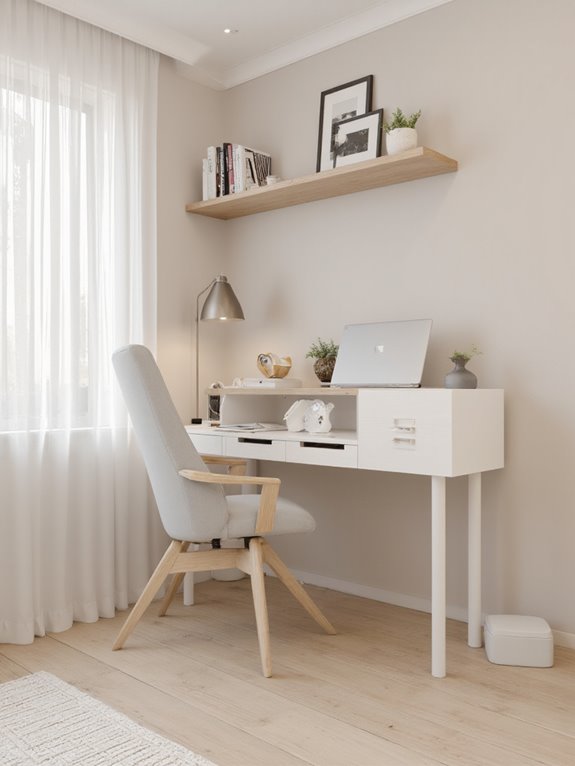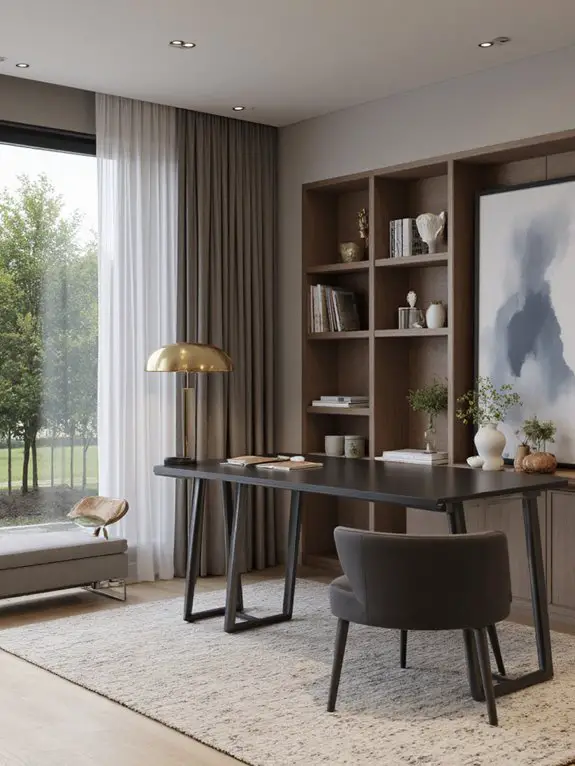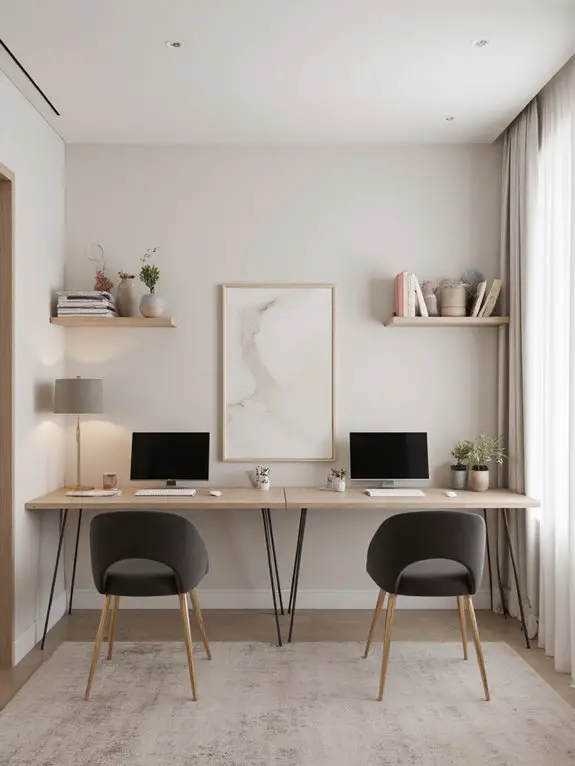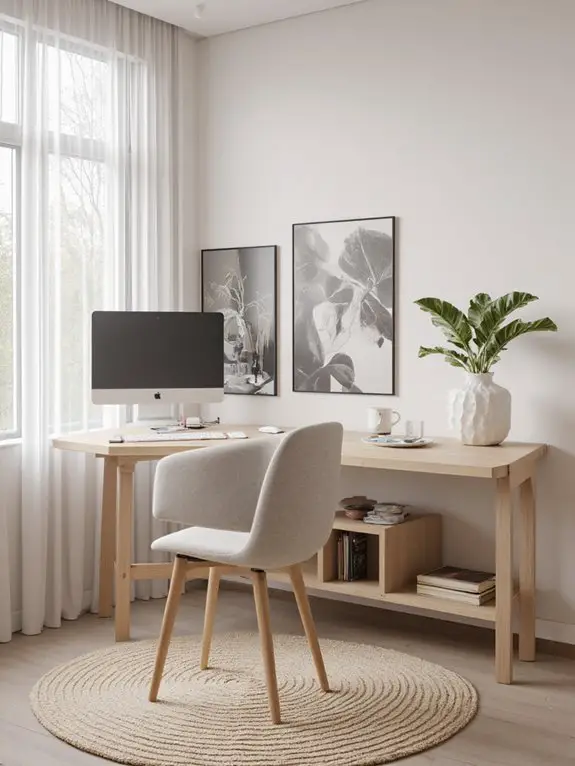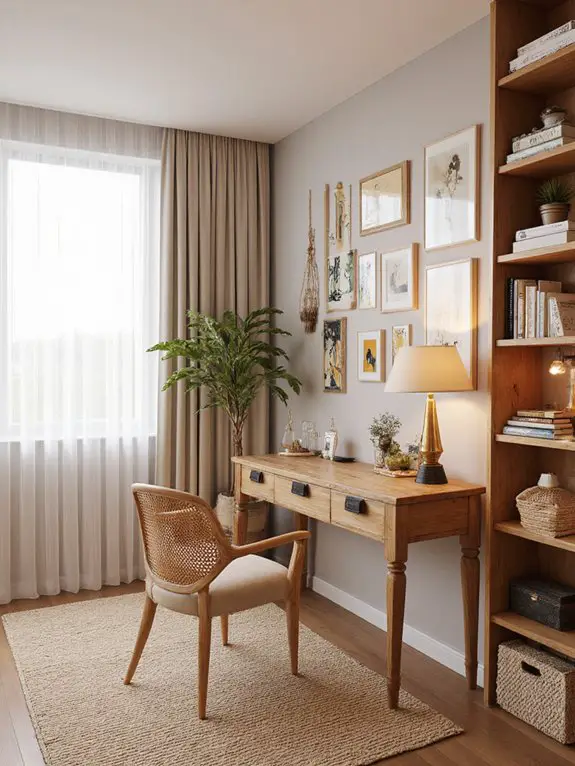To create a mini home office in your quarto, I focus on space-saving and multi-functional solutions. I use wall shelves and floating desks to maximize vertical space, keeping the area open and clutter-free. Compact, foldable furniture like desks and chairs offers flexibility, while rolling carts and mobile desk caddies guarantee easy access to supplies. Light color palettes and layered lighting enhance the serene ambiance. For even more practical tips, stay tuned.
Utilize Vertical Space With Wall Shelves
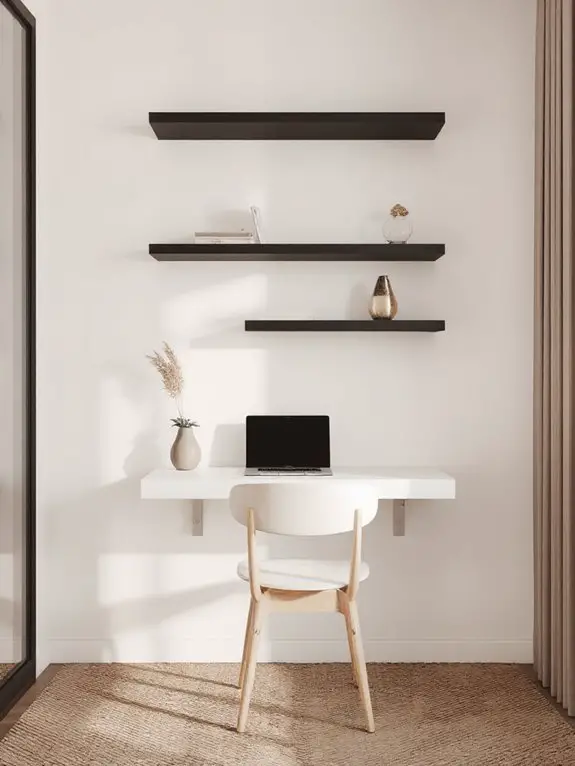
When I’m working with limited space, I’ve found that wall shelves are an essential tool for maximizing vertical space and keeping my home office organized. Floating shelves keep clutter off my desk while storing books, supplies, or decor. I prefer sturdy brackets and deep shelves for heavier items like printers or binders.
Lighter materials work for notebooks and small plants. Arranging them in staggered patterns adds visual interest without wasting space. I also use vertical file holders or baskets on lower shelves for easy access. Proper spacing guarantees everything stays within reach while maintaining a clean, functional workspace.
Opt for a Compact Desk Design
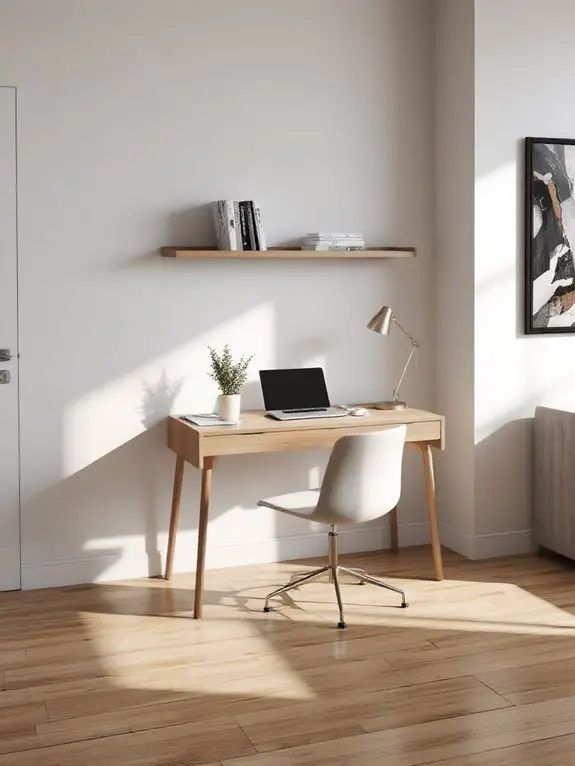
Since space is often a premium in a mini home office, I’ve learned that choosing a compact desk design can make all the difference. A smaller desk doesn’t mean sacrificing functionality; it’s about maximizing efficiency.
I prefer designs with built-in storage, like drawers or shelves, to keep essentials organized and within reach. Opting for a slim, minimalist desk also helps maintain an open, uncluttered feel.
Materials like lightweight wood or metal guarantee durability without overwhelming the space. I’ve found that positioning the desk against a wall or in a corner maximizes floor area, creating a more productive and comfortable working environment.
Incorporate Foldable Furniture
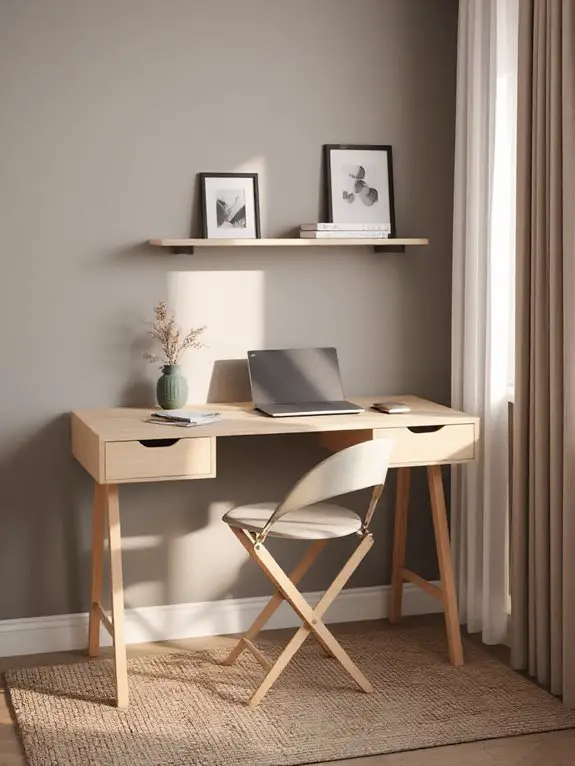
Flexibility is key when designing a mini home office, and foldable furniture offers a smart solution for maximizing limited space. I’ve found that a foldable desk or wall-mounted table can easily be tucked away when not in use, freeing up valuable floor space.
Foldable chairs are another great option—they’re lightweight and can be stored in a closet or behind a door.
I also recommend a foldable shelving unit for organizing supplies; it’s versatile and takes up minimal room. By incorporating foldable furniture, I’ve created a workspace that’s functional yet adaptable, perfect for small living areas or multi-purpose rooms.
Choose Multi-Functional Pieces
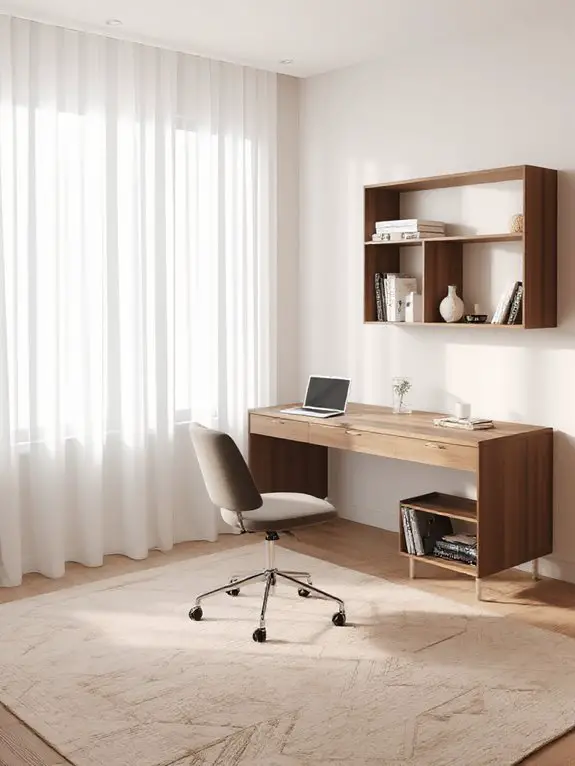
Multi-functional pieces are essential for maximizing efficiency in a mini home office, as they allow you to do more with less space. I always look for furniture that serves dual purposes, like a desk with built-in shelving or a bench that doubles as storage.
A foldable desk chair that can be tucked away when not in use is another smart choice. I also consider items like a printer stand that includes drawers for office supplies or a bookshelf that acts as a room divider.
These pieces not only save space but also keep my workspace organized and functional, making the most of every square inch.
Use a Rolling Cart for Storage
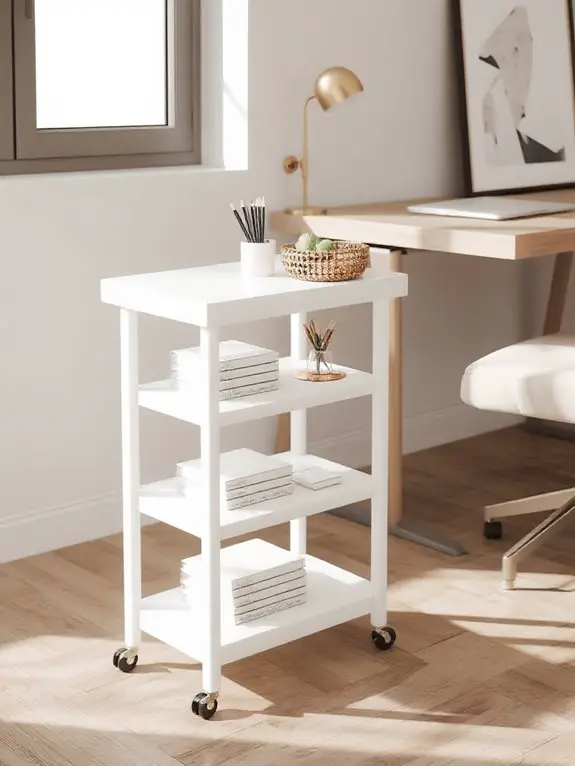
A rolling cart has become a game-changer in my mini home office setup, offering both mobility and ample storage without taking up much floor space. I use it to organize office supplies, notebooks, and even my laptop when I need a quick workspace shift. Its wheels make it easy to move around, so I can reposition it based on my needs throughout the day.
I also appreciate the vertical storage tiers, which keep everything accessible yet neat. For small spaces, it’s a practical solution that maximizes efficiency without cluttering the room. It’s both functional and adaptable, fitting seamlessly into my workflow.
Mount a Floating Desk
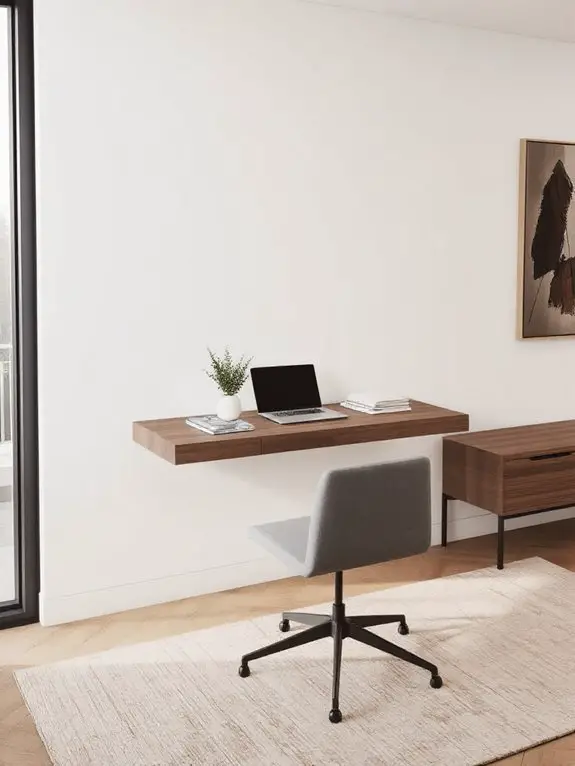
When space is at a premium, mounting a floating desk can be a smart way to carve out a functional workspace without sacrificing floor area. I’ve found that choosing a sturdy shelf or custom-built desk and securing it to the wall with brackets creates a clean, minimalist look.
Measuring the available wall space and ensuring the desk aligns with ergonomic height guidelines is essential. I prefer using lightweight materials like plywood or MDF for a streamlined appearance.
Adding a lip or edge to prevent items from sliding off can also enhance practicality. This approach maximizes utility while keeping the room uncluttered.
Install a Wall-Mounted Organizer
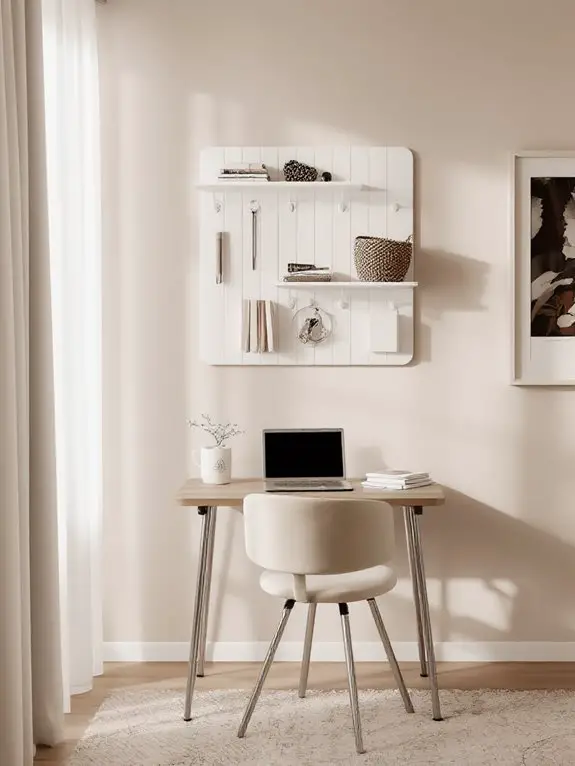
To keep my workspace tidy and efficient, I’ve discovered that installing a wall-mounted organizer is incredibly effective. It maximizes vertical space, freeing up my desk for essential tasks. I chose one with compartments for pens, notebooks, and small gadgets, ensuring everything has its place.
Mounting it at eye level keeps items easily accessible while maintaining a clean look. I opted for a sleek, minimalist design that complements my office décor without overwhelming the small space.
Add a Pegboard for Tools and Supplies
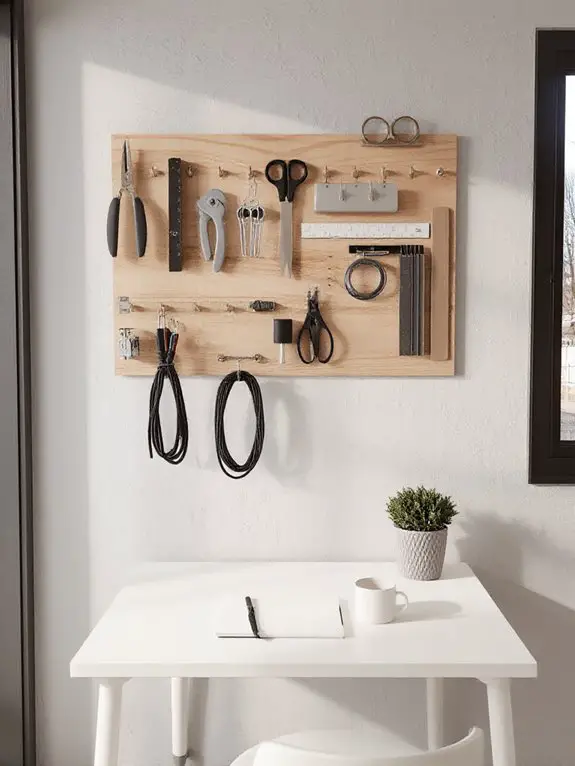
Since I’ve been working on optimizing my mini home office, adding a pegboard has transformed how I organize my tools and supplies. It’s a versatile solution that keeps everything within reach yet off the desk, saving precious surface space.
I’ve found that using hooks, bins, and shelves on the pegboard allows me to customize the layout for my specific needs—pens, scissors, chargers, and even small notebooks all have their place.
The visual layout makes it easy to grab what I need quickly, reducing clutter and boosting productivity. It’s a simple addition that’s made a big difference in maintaining order.
Select a Narrow Console Table
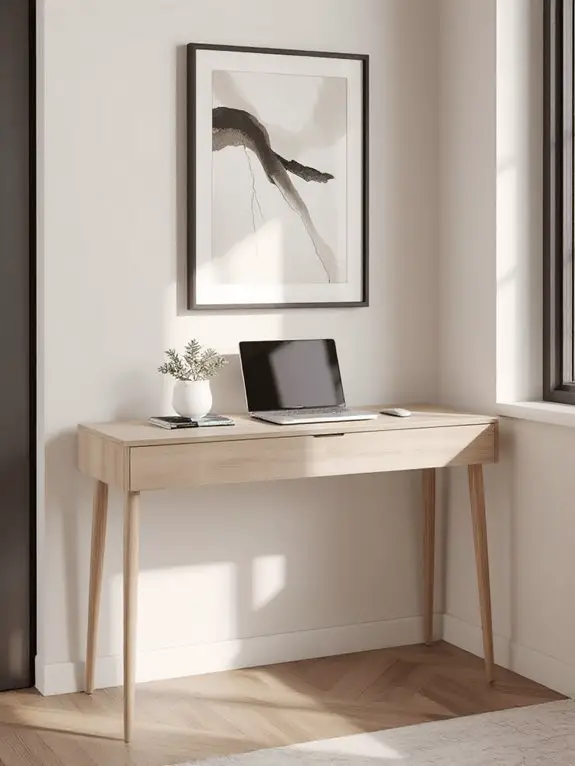
A narrow console table can be a game-changer for maximizing space in a mini home office. I’ve found that it fits snugly against a wall, freeing up floor space while providing a functional surface. Look for one that’s sleek and minimalist, ideally around 10-12 inches deep, so it doesn’t overwhelm the room.
A glass or metal top can make the space feel airier, while wood adds warmth. I always measure the area first to guarantee it fits perfectly. Its slim profile makes it versatile—it can double as a desk or storage spot without making the room feel cluttered.
Incorporate Hidden Storage Solutions
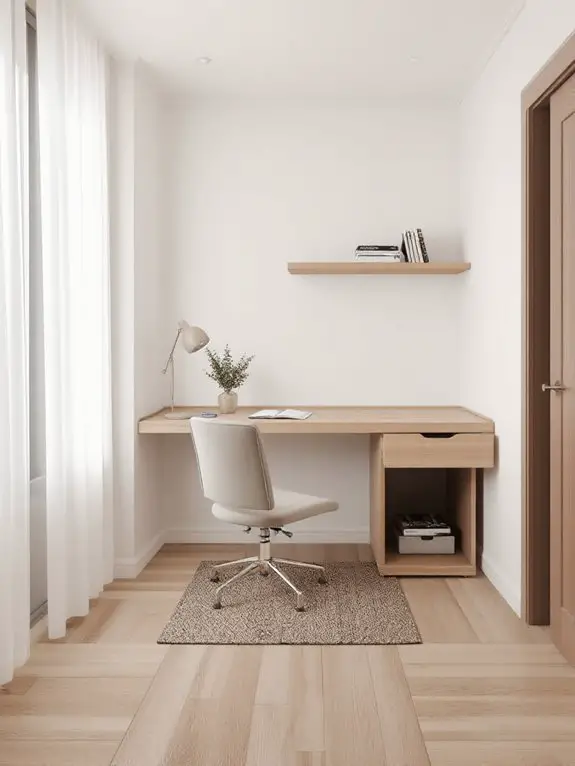
Although space is limited in a mini home office, hidden storage solutions can transform clutter into seamless organization. I’ve found that using furniture with built-in compartments, like ottomans with lift-up lids or desks with hidden drawers, maximizes functionality without sacrificing style.
Wall-mounted shelves with concealed cubbies or cabinets keep essentials out of sight but within reach. Even a magnetic strip behind a monitor can stash small items like paper clips or USB drives.
For paperwork, I use decorative boxes or fabric bins that double as decor. These clever ideas create a tidy, efficient workspace, proving that small changes make a big impact.
Use a Corner Desk Setup
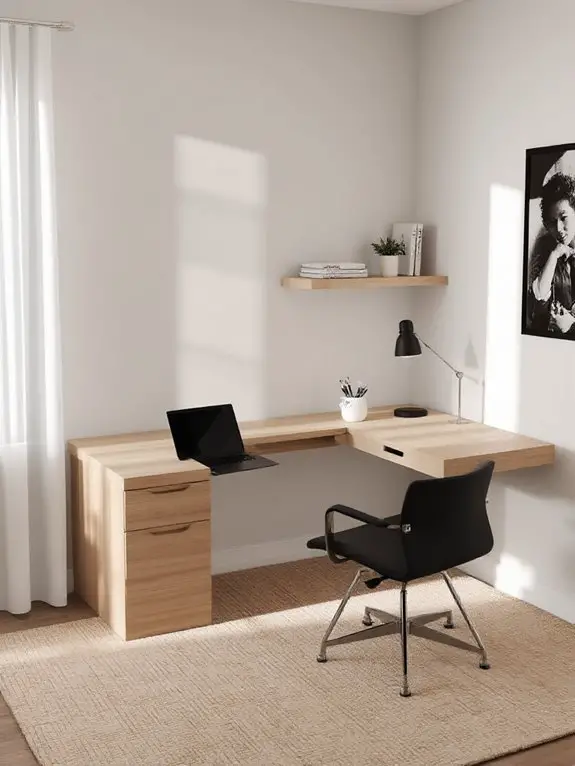
Making the most of a mini home office often means optimizing every inch of space, and a corner desk setup can be a game-changer. By tucking a desk into a corner, I maximize floor space while creating a dedicated work zone.
A corner desk provides ample surface area for my laptop, notebook, and other essentials without overwhelming the room. I prefer an L-shaped design for added versatility, allowing me to separate tasks efficiently.
Positioning it near a window also brings in natural light, boosting productivity. This setup not only saves space but also helps me feel organized and focused in my compact workspace.
Add a Bookshelf for Dual Functionality
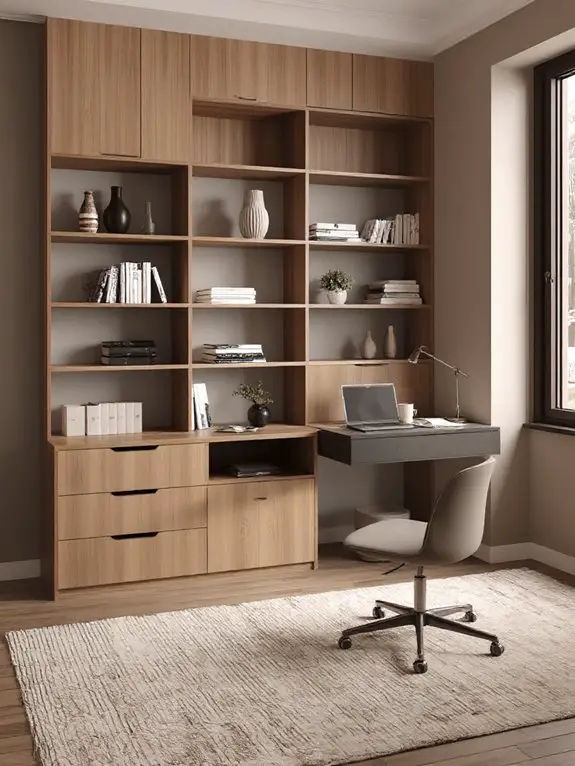
Incorporating a bookshelf into a mini home office adds both storage and style, turning a functional piece of furniture into a multitasking asset. I recommend choosing a shelf that complements your desk and fits the available space without overwhelming it.
Use it to organize books, binders, and office supplies, but also display decorative items like plants or framed photos to personalize the area. Opt for adjustable shelves if possible, as they allow customization for different-sized items.
A bookshelf can also act as a room divider, subtly separating your workspace from the rest of the room while maintaining an open feel.
Choose a Minimalist Aesthetic
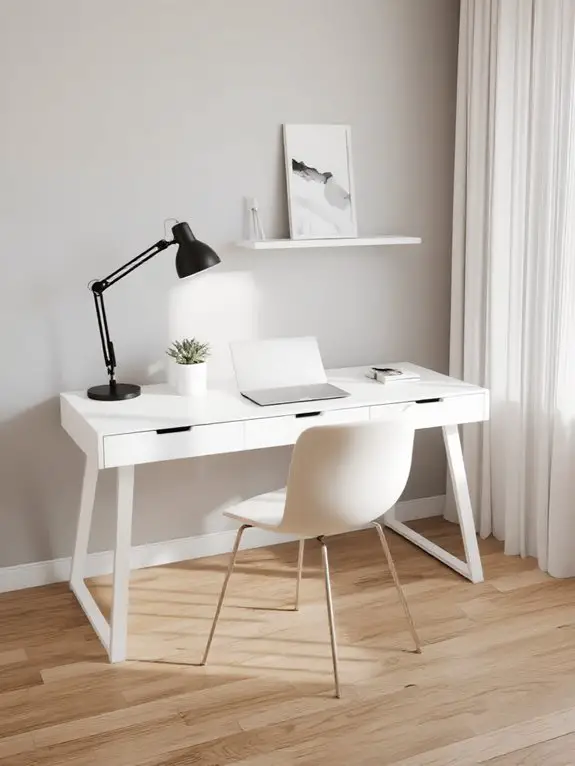
A minimalist aesthetic can transform your mini home office into a clutter-free, focused environment that enhances productivity and calm. I prioritize clean lines, neutral colors, and simple furniture to create a serene workspace.
I eliminate unnecessary items, keeping only what’s essential for work. I opt for sleek storage solutions like floating shelves or concealed cabinets to maintain visual simplicity.
I choose a limited color palette, such as whites, grays, or soft earth tones, to promote a sense of order. By reducing distractions and embracing simplicity, I find it’s easier to concentrate and feel inspired in my mini office.
Integrate a Murphy Desk
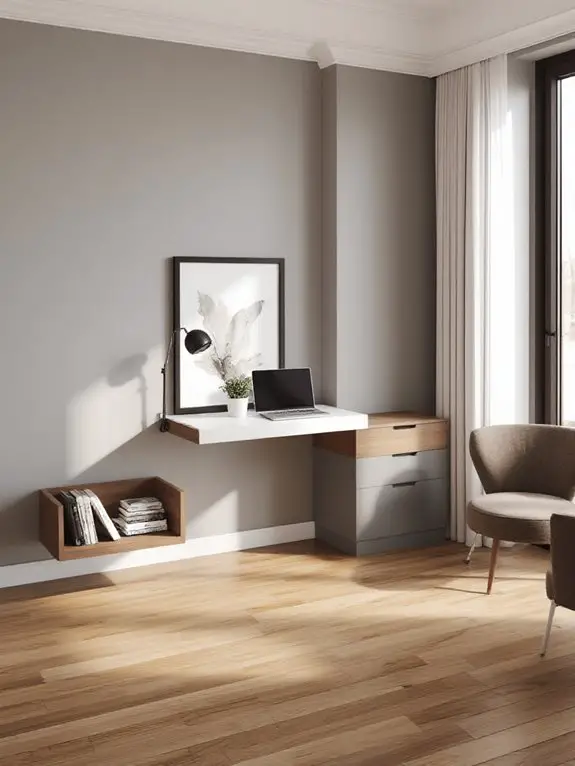
Since space is often limited in a mini home office, I find that a Murphy desk is an incredibly functional solution to maximize efficiency without sacrificing style. This fold-down desk seamlessly blends into the wall when not in use, freeing up valuable floor space.
I recommend opting for a design with built-in shelving or storage compartments to keep essentials organized. Choosing a sleek, modern finish guarantees it complements your decor.
For added convenience, pair it with a wall-mounted monitor or a compact chair that can be tucked away. A Murphy desk is a smart, space-saving investment for any mini office setup.
Use a Ladder Desk for Compact Spaces
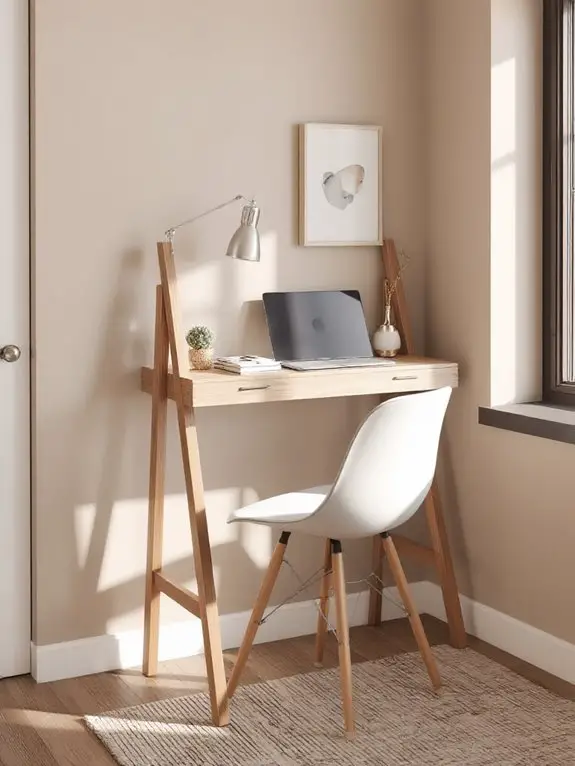
When floor space is at a premium, a ladder desk offers a stylish yet practical solution that doesn’t compromise on functionality. I’ve found it’s perfect for small home offices because it combines vertical storage with a compact footprint.
The shelves or rungs act as additional storage for books, supplies, or decor, while the foldable or slim design maximizes floor space. I recommend choosing one with a built-in desk surface that’s sturdy enough for your laptop or paperwork.
Its minimalist aesthetic also blends seamlessly with modern or rustic decor, making it a versatile choice for any style.
Add a Window Nook Workspace
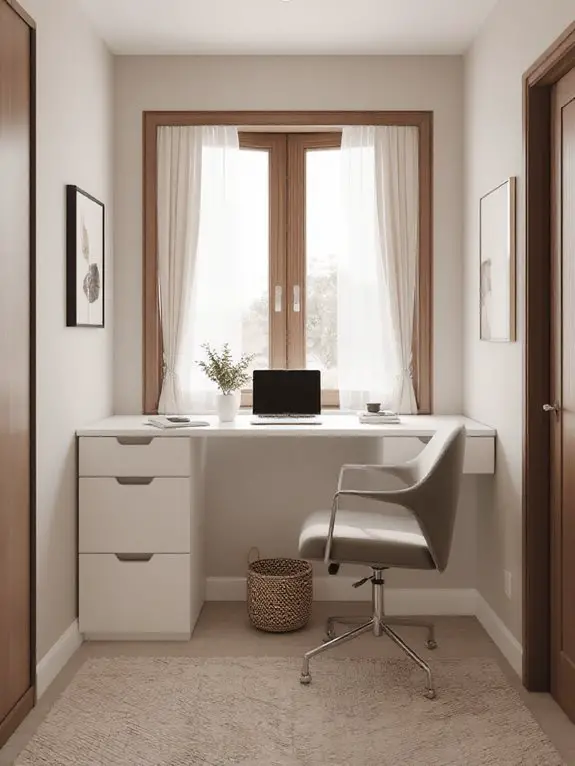
Creating a window nook workspace not only maximizes natural light but also transforms an overlooked corner into a functional and inspiring area. I’d start by measuring the space to guarantee it fits a small desk or shelf that aligns with the window’s width. A streamlined floating shelf can work wonders, keeping the area open and airy.
Positioning my chair to face the window allows me to enjoy the view and daylight, which boosts focus. I’d add soft cushions or a small bench for comfort and consider lightweight, neutral decor to maintain a calm ambiance without overcrowding the space.
Incorporate a Small Side Table Desk
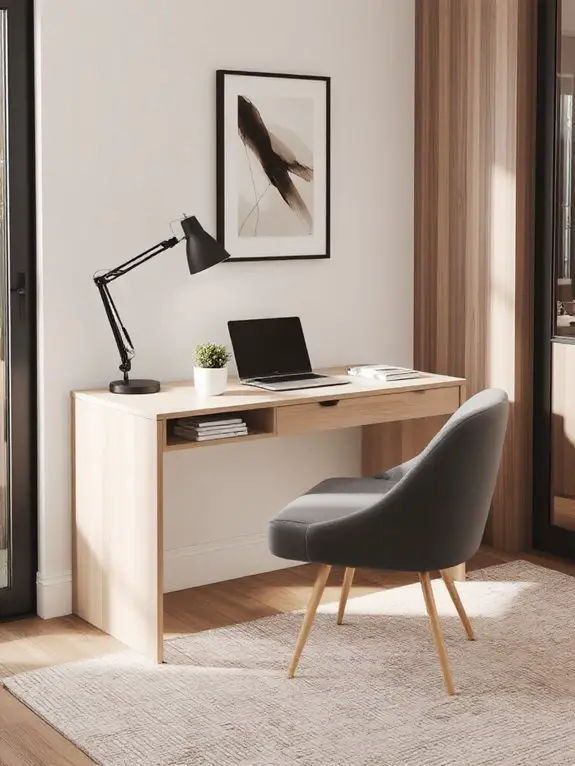
A small side table desk can be an excellent solution for tight spaces that still need a functional workstation. When I needed a compact workspace, I chose a slim side table that fit perfectly in a corner or beside a chair. I made sure it was sturdy enough for my laptop and notebook, with enough surface area to avoid feeling cluttered.
Pairing it with a wall-mounted lamp freed up desk space, and a sleek design kept it visually light. Even in a small room, this setup allowed me to work efficiently without overwhelming the area, proving that practicality doesn’t require bulk.
Use Baskets for Hidden Storage
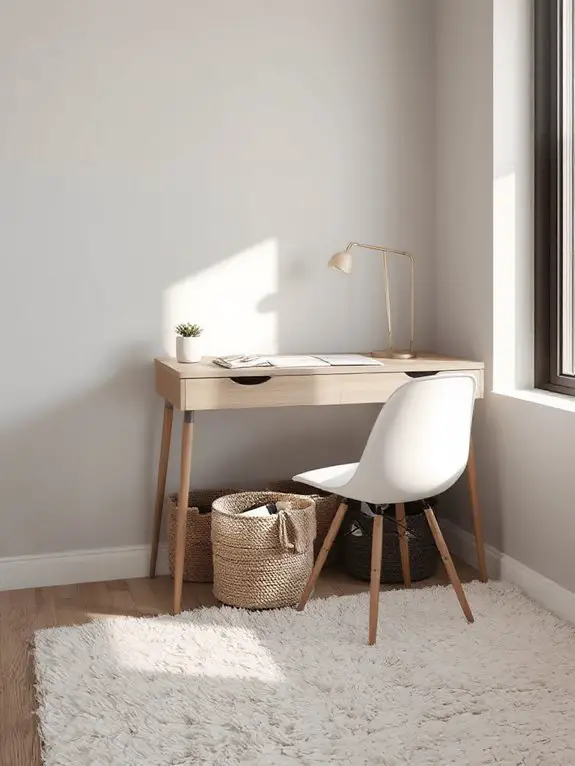
Baskets offer a versatile and stylish way to keep a mini home office organized and clutter-free. I use woven bins to stash loose papers, cables, and office supplies, keeping surfaces tidy. Placing them under my desk or on shelves maximizes vertical space without sacrificing style.
Fabric baskets can double as decorative elements, enhancing the room’s aesthetic while hiding essentials. For smaller items, I opt for compartmentalized baskets to sort pens, sticky notes, or chargers.
Strategically placing baskets near seating areas also helps store books or notebooks within reach. This simple solution maintains order and guarantees everything has its place.
Add a Chic Room Divider
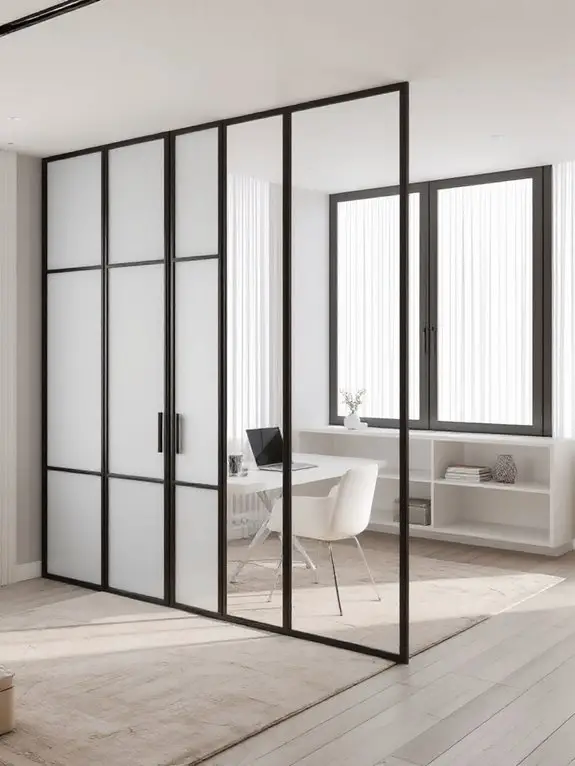
When space is limited, I’ve found that a chic room divider can be a game-changer for defining my mini home office within a larger room. A stylish screen or bookshelf divider not only separates my workspace from distractions but also adds personality to the area.
I opt for lightweight, foldable screens for flexibility or open shelving units that double as storage for books and decor. Placement is key—I position it to maximize natural light while creating a sense of privacy. Choosing a design that complements the room’s aesthetic guarantees the divider feels intentional, not intrusive.
Optimize Lighting for a Cozy Feel
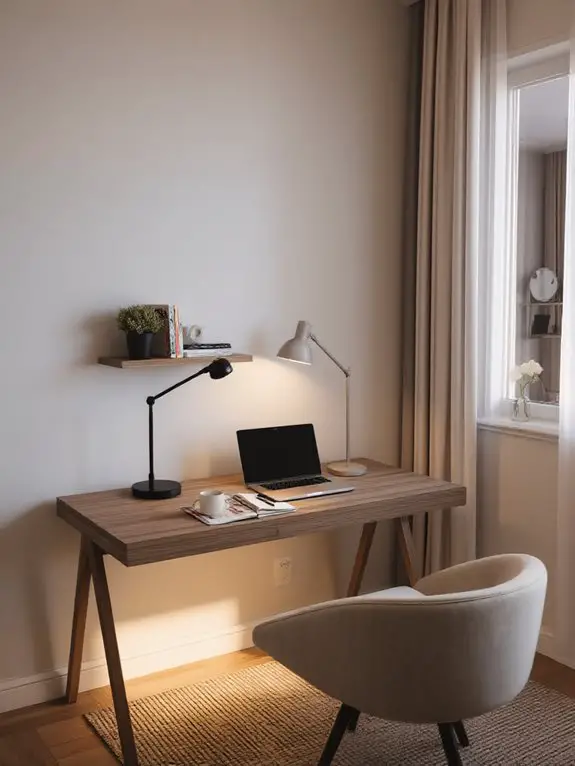
Proper lighting can transform a mini home office from a functional space into an inviting retreat. I’ve found that layering light sources creates warmth and depth.
Start with ambient lighting, like a soft ceiling fixture, to evenly illuminate the room. Then, add task lighting, such as a desk lamp with adjustable brightness, for focused work.
Incorporate accent lighting, like a small table lamp or string lights, to add personality and coziness. I prefer warm-toned bulbs, around 2700K, as they feel welcoming and reduce eye strain.
Positioning lights to minimize shadows and glare guarantees a comfortable, productive environment.
Use a Fold-Down Desk
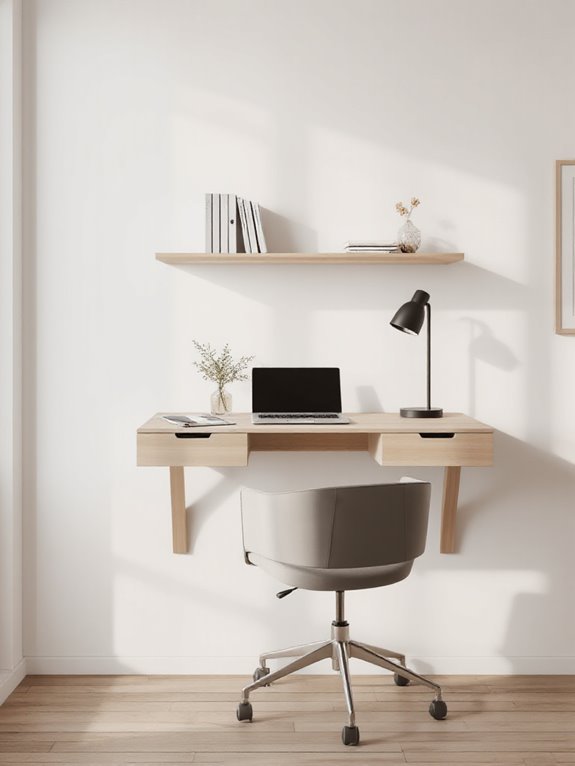
If space is limited in your home office, a fold-down desk can be a game-changer. I’ve found it’s perfect for small rooms or multipurpose spaces, as it folds neatly against the wall when not in use. Look for one with sturdy hinges and enough surface area for your laptop or writing materials.
I recommend pairing it with wall-mounted shelves or organizers to keep essentials handy without cluttering the desk. It’s also a smart choice if you share the space—you can easily fold it away to reclaim the room.
This simple solution maximizes functionality without sacrificing style or convenience.
Incorporate a Compact File Cabinet
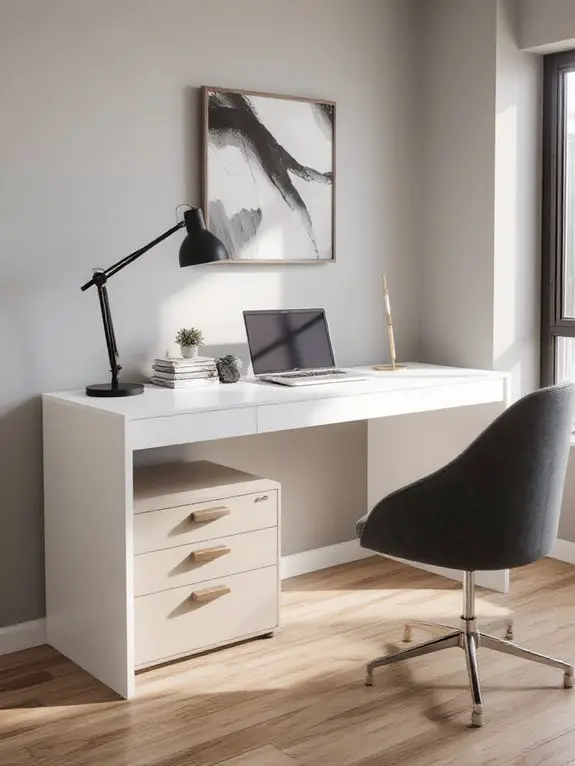
While keeping your home office organized is essential, a compact file cabinet can make a significant difference in managing paperwork efficiently. I’ve found that a small, vertical cabinet with multiple drawers helps categorize documents neatly—bills, receipts, and important files all stay accessible.
Look for one with a slim design to save floor space or a model with wheels for added mobility. I prefer cabinets with built-in locks to secure sensitive information. Stainless steel or wood finishes can blend seamlessly with your decor.
Add a Mobile Desk Caddy
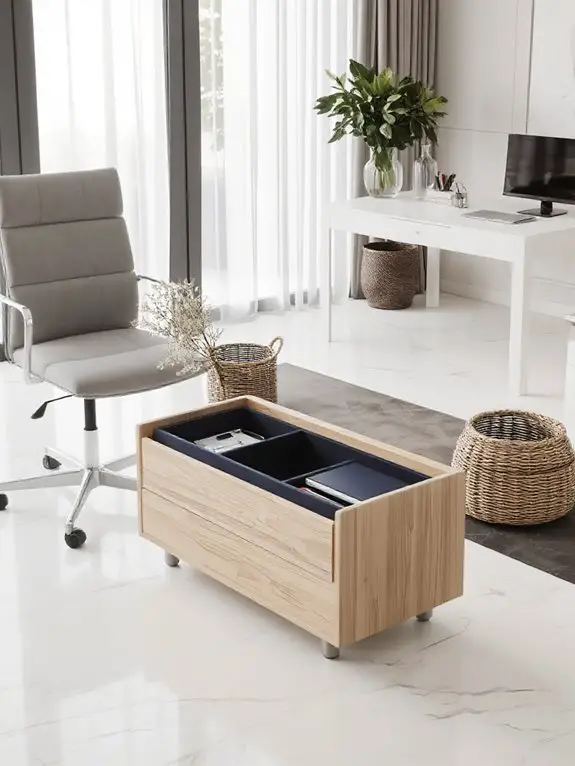
Since desk space is often limited in a mini home office, a mobile desk caddy can be a game-changer for keeping essentials within reach without cluttering your workspace. I’ve found that choosing one with compartments for pens, notepads, and smaller accessories like paper clips or sticky notes helps me stay organized.
Rolling caddies are especially handy because I can move them around as needed, whether I’m working at my desk or shifting to another spot. Look for a sturdy yet compact design that fits seamlessly into your setup.
It’s a simple addition that maximizes efficiency without sacrificing style or function.
Utilize Under-Stair Space
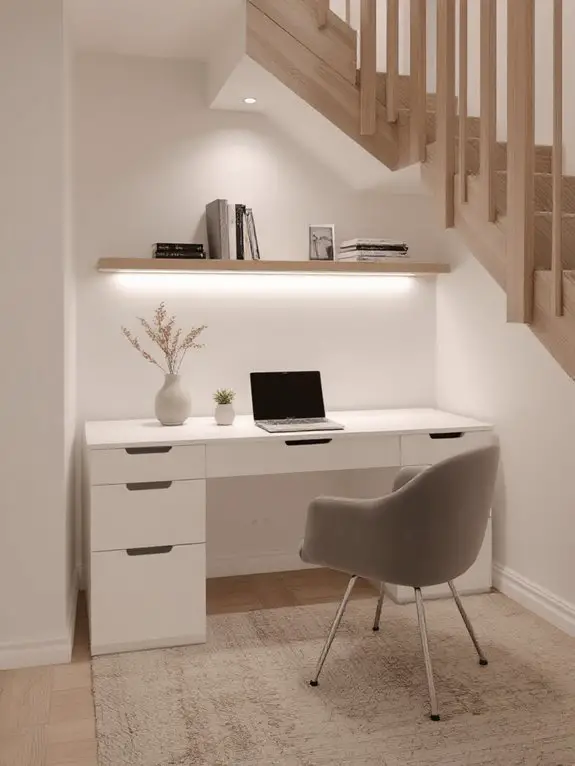
Making the most of under-stair space can transform an overlooked area into a functional and stylish part of your mini home office. I’d start by measuring the space to determine if it can accommodate a built-in desk, shelves, or storage units. Custom carpentry guarantees a seamless fit, but pre-made furniture can work too.
I’d prioritize ergonomics, guaranteeing the desk height and chair placement are comfortable for extended use. Maximizing vertical storage with wall-mounted organizers or cubbies keeps supplies within reach.
Lighting is essential—I’d install task lighting or use a small lamp to brighten the workspace. This approach creates a practical, space-saving office.
Choose a Light Color Palette
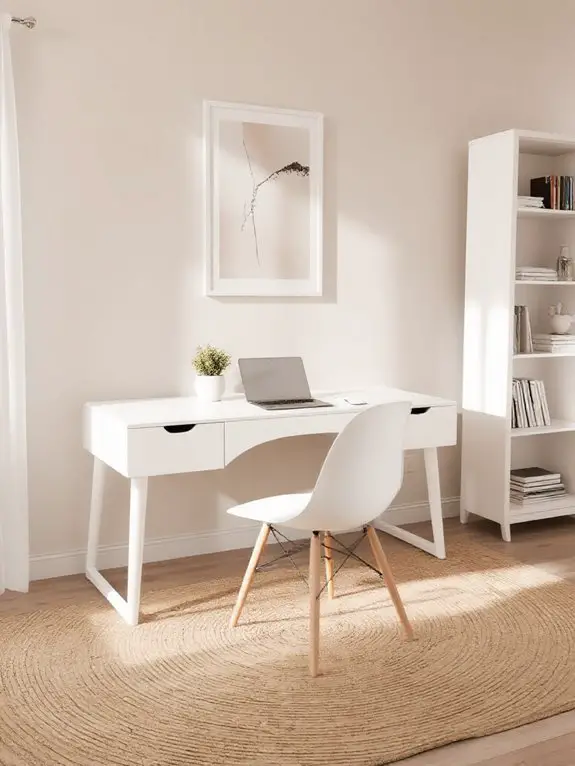
To create a calming and productive mini home office, I’d recommend choosing a light color palette that enhances the sense of space and brightness. Light tones like soft whites, pastels, or muted neutrals can make even the smallest area feel airy and open. I typically avoid dark colors, as they can make a compact space feel claustrophobic.
Pairing these shades with natural light creates an uplifting environment, perfect for focus. I’ve found that accenting with one or two brighter colors—maybe a vibrant plant or artwork—adds personality without overwhelming the serene vibe. It’s a timeless approach that works wonders.
Frequently Asked Questions
How Can I Reduce Noise in My Mini Home Office?
I can reduce noise in my mini home office by adding heavy curtains, using a white noise machine, placing rugs on the floor, and installing acoustic panels. I’ll also seal gaps around doors and windows to block sound.
What Plants Are Best for a Small Office Space?
I’d recommend low-maintenance plants like pothos, snake plants, or ZZ plants for a small office. They’re great for air quality, don’t need much light, and thrive in tight spaces without taking over my desk.
How Do I Choose Ergonomic Furniture for My Home Office?
I’d start by measuring my space to guarantee the furniture fits comfortably. I’d opt for an adjustable chair with lumbar support and a desk at elbow height to promote proper posture and reduce strain during long workdays.
Can I Use a Mini Home Office in a Shared Living Space?
I transformed a corner of my living room into a mini home office using a sleek wall-mounted desk and a folding chair. It’s compact yet functional, blending seamlessly with our shared space without feeling intrusive.
How Do I Manage Cables in a Compact Workspace?
I manage cables in a compact workspace by using cable clips or sleeves to keep them tidy, routing them along desk edges, and utilizing a cable organizer box to hide excess wires, ensuring a clean and functional setup.

